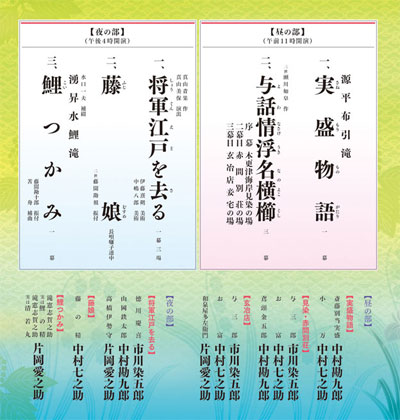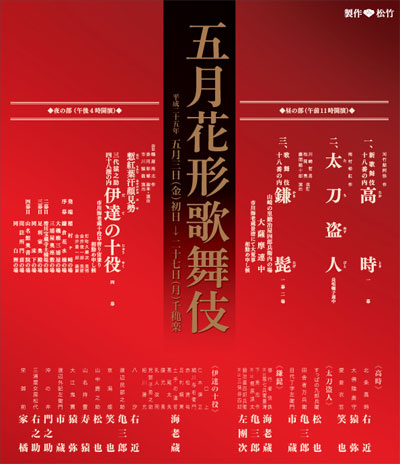| Comments |
Second month celebrating the opening of the new Kabukiza within a 1-year long cycle of kokera otoshi programs!
Tsuru Kame: the crane (tsuru) is said to live for a thousand
years, the tortoise (kame) is said to live for ten thousand years.
Together, they are a traditional symbol of longevity. There is no particular plot
to this play, but simply shows a visit by the emperor to the Moon Pavilion where
two courtiers dance as the spirits of the crane and tortoise.
Starring Nakamura Baigyoku as the emperor, Nakamura Kanjaku as the spirit of the crane and
Nakamura Hashinosuke as the spirit of the tortoise.
Terakoya: Genz˘ and his wife Tonami run a small school and are
protecting Kan Sh˘j˘'s son and heir, saying that he is their son. However,
word has gotten out Kan Sh˘j˘'s son is there and Genz˘ has been ordered to
behead him. Moreover, Matsu˘maru is to come to inspect the head. Their only
alternative is to kill one of the other students as a substitute, but all of
the students are farmer's children who could never pass for the son of a court
aristocrat. However, a new boy arrives that day and Genz˘ makes the terrible
decision to kill him in the place of his lord. As it turns out, Matsu˘maru has
sent his own son to be sacrificed, because of his family's long loyalty to
Kan Sh˘j˘. But he must face the most terrible situation for a father,
inspecting the head of his own son and lying when he says that it is the
genuine head of the son of Kan Sh˘j˘. Finally Matsu˘maru reveals his true
feelings to Genz˘ and he and his wife Chiyo mourn their dead son.
Starring Matsumoto K˘shir˘ as Matsu˘maru, Band˘ Mitsugor˘ as Genz˘, Nakamura Kaishun as Chiyo and Nakamura Fukusuke as Tonami.
Featuring also Band˘ Hikosabur˘ as Shund˘ Genba.
Sannin Kichisa:
(Three Thieves Named Kichisa)
The playwright Kawatake Mokuami excelled at portrayals of thieves and this short scene,
with its music and poetic lines, is one of his most famous.
A beautiful young woman helps out a woman who is lost on the road.
But she is actually Oj˘ Kichisa, a male thief who is disguised as a woman.
He steals an immense sum of money that the woman is carrying and this leads to
an encounter on this riverbank of three thieves, all with the name Kichisa.
The two others Kichisa are Osh˘ Kichisa, a bonze turned thief, and Ob˘ Kichisa, an ex-samurai turned thief
Though they start out as rivals, they decide to become blood brothers
and form a gang. Featuring Living National Treasure Onoe Kikugor˘ as Oj˘ Kichisa, Matsumoto K˘shir˘ as Osh˘ Kichisa and Kataoka Nizaemon as Ob˘ Kichisa.
Meiboku Sendai Hagi: this play is about the attempt to take over one of
the most famous samurai households in the Edo period, the Date clan
ruling Sendai, a scandal that caused a sensation in its day.
After the death of the lord of the clan, his young heir is the target of
villains. Masaoka (Living National Treasure Sakata T˘jűr˘), the boy's nurse is desperately afraid that he
will be poisoned. She refuses to let anyone see him who might try to
assassinate him and attempts to keep him safe in the women's quarters
where men are forbidden. She even fixes his meal in her quarters using
her delicate tea ceremony implements to cook rice. The plotting faction does
not give up, though, and sends poison in the form of candy as a present
from the Sh˘gun. Masaoka's son Senmatsu sacrifices his life for the young
lord by eating the poisoned candy, and when he is killed by the evil Yashio (Nakamura Baigyoku),
Masaoka thinks only of protecting her lord. Her fierce devotion to duty convinces the
plotters that she is on their side. Masaoka's actions help save the young lord,
and only when she is alone can she grieve for her son.
As another faithful retainer Otokonosuke (Nakamura Kichiemon), stands guard underneath
the room, the evil Nikki Danj˘ (Matsumoto K˘shir˘) appears as a giant rat, but then
slips away, walking calmly through the clouds.
Featuring also Nakamura Tokiz˘ (Okinoi), Kataoka Hidetar˘ (Sakae Gozen) and Nakamura Senjaku (Matsushima).
Yoshidaya: the roots of this play go back to the earliest days of
Kabuki. Izaemon, the son of a wealthy family, has been disowned for loving a
courtesan and now has nothing but a paper kimono. This role is a classic
example of the wagoto or soft style of
acting that is one of the representative acting styles of the Kansai region.
Kataoka Nizaemon stars as Izaemon, a role that is a specialty of his family's Kansai
acting style. Featuring Band˘ Tamasabur˘ as the courtesan ďgiya Yűgiri (Izaemon's lover),
Band˘ Yajűr˘ and Kataoka Hidetar˘ as the proprietor and proprietress of the Yoshidaya teahouse
and Kataoka Nizaemon's grandson Kataoka Sennosuke as a comic entertainer in the pleasure quarters.
Ishikiri Kajiwara: the Heike general Kajiwara (Nakamura Kichiemon) is asked to
test the sharpness of a sword by slicing two live human beings in half.
He deliberately makes the sword fail the test to keep the sword,
a priceless heirloom belonging to the enemy Genji clan, from falling into
the hands of his Taira clan. A miracle has convinced Kajiwara to change sides.
Kajiwara finally demonstrates the true power of the sword by cutting a
large stone basin in two.
Featuring also Onoe Kikugor˘, Nakamura Shibajaku, Nakamura Kinnosuke, Nakamura Karoku and Nakamura Matagor˘.
Ninin D˘j˘ji: a beautiful young woman dances under cherry blossoms
at a dedication ceremony for a temple bell. She dances the many aspects of a
woman in love, but is actually the spirit of a serpent, driven to destroy the
bell out of jealousy. In addition to being the most famous of all Kabuki dances,
"Musume D˘j˘ji" is considered to be the pinnacle of the art of the onnagata
female role specialist. Living National Treasure Band˘ Tamasabur˘, whose beauty and artistic genius is renowned
throughout the world, will give his definitive performance of this dance
in a special double version together with young onnagata star
Onoe Kikunosuke.
Sources: Earphone Guide Website or Sh˘chiku Kabuki Official Website
|






